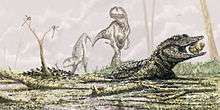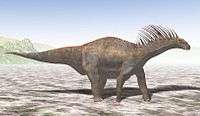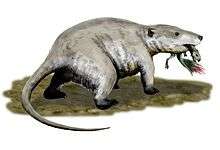Barremian
The Barremian is an age in the geologic timescale (or a chronostratigraphic stage) between 129.4 ± 1.5 Ma (million years ago) and 125.0 ± 1.0 Ma). It is a subdivision of the Early Cretaceous epoch (or Lower Cretaceous series). It is preceded by the Hauterivian and followed by the Aptian stage.[2]
| System/ Period |
Series/ Epoch |
Stage/ Age |
Age (Ma) | |
|---|---|---|---|---|
| Paleogene | Paleocene | Danian | younger | |
| Cretaceous | Upper/ Late |
Maastrichtian | 66.0 | 72.1 |
| Campanian | 72.1 | 83.6 | ||
| Santonian | 83.6 | 86.3 | ||
| Coniacian | 86.3 | 89.8 | ||
| Turonian | 89.8 | 93.9 | ||
| Cenomanian | 93.9 | 100.5 | ||
| Lower/ Early |
Albian | 100.5 | ~113.0 | |
| Aptian | ~113.0 | ~125.0 | ||
| Barremian | ~125.0 | ~129.4 | ||
| Hauterivian | ~129.4 | ~132.9 | ||
| Valanginian | ~132.9 | ~139.8 | ||
| Berriasian | ~139.8 | ~145.0 | ||
| Jurassic | Upper/ Late |
Tithonian | older | |
| Subdivision of the Cretaceous system according to the ICS, as of 2017.[1] | ||||
Stratigraphic definitions
The original type locality for the Barremian stage is in the vicinity of the village of Barrême, Alpes-de-Haute-Provence, France. Henri Coquand defined the stage and named it in 1873.
The base of the Barremian is determined by the first appearance of the ammonites Spitidiscus hugii and Spitidiscus vandeckii. The end of the Barremian is determined by the geomagnetic reversal at the start of the M0r chronozone, which is biologically near the first appearance of the ammonite Paradeshayesites oglanlensis.
Regional equivalents
The Barremian falls in the Gallic epoch, a subdivision of the Cretaceous that is no longer used by the ICS. It overlaps the lower part of the Urgonian stage, which is sometimes used in western European stratigraphy. In North America, the late Coahulian and the early Comanchean correspond to the Barremian. In New Zealand, it falls within the Mokoiwian, and in Japan it corresponds to the late Aritan.[2]
Subdivision
The Barremian is often subdivided into two substages or subages, Lower/Early and Upper/Late Barremian.
In the Tethys domain, the Barremian stage contains eleven ammonite biozones:
- zone of Pseudocrioceras waagenoides
- zone of Colchidites sarasini
- zone of Imerites giraudi
- zone of Hemihoplites feraudianus
- zone of Gerhardtia sertousi
- zone of Ancyloceras vandenheckii
- zone of Coronites darsi
- zone of Kotetishvilia compressissima
- zone of Nicklesia pulchella
- zone of Nicklesia nicklesi
- zone of Spitidiscus hugii
Palaeontology
Much knowledge about the Barremian fauna—especially regarding birds, mammals and pterosaurs—is derived from the famous Yixian Formation of China, part of which dates from this stage.
†Ammonoidea
|
|
|
|
Neocoleoids
| Neocoleoids of the Barremian | ||||
|---|---|---|---|---|
| Taxa | Presence | Location | Description | Images |
|
Maioteuthis |
||||
|
Neololigosepia |
||||
†Belemnites
| Belemnites of the Barremian | ||||
|---|---|---|---|---|
| Taxa | Presence | Location | Description | Images |
 Belemnites | ||||
Nautiloidea
| Nautiloids of the Barremian | ||||
|---|---|---|---|---|
| Taxa | Presence | Location | Description | Images |
|
Eucymatoceras |
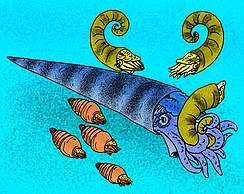 An illustration of a variety of fossil nautiloids. | |||
|
Pseudaturoidea |
||||
Chondrichthyes
- Hexanchidae: Notidanodon lanceolatus, Notorynchus aptiensis
Crocodylomorphs
| Crocodylomorphs of the Barremian | ||||
|---|---|---|---|---|
| Taxa | Presence | Location | Description | Images |
| Western Europe and North America | A genus of basal neosuchian crocodyliform. At only 60 centimetres in length, Bernissartia is one of the smallest crocodyliforms that ever lived. |
| ||
| 130–125 Ma | Isle of Wight | A genus of basal neosuchian crocodyliform. It was very similar to its contemporary and closely related Bernissartia. | ||
| Vectis Formation, Wealden Group, Isle of Wight | An eusuchian crocodyliform, currently the oldest one known. | |||
†Cerapoda
| Cerapoda of the Barremian | ||||
|---|---|---|---|---|
| Taxa | Presence | Location | Description | Images |
| USA |
   | |||
| Japan | ||||
| England | ||||
| Belgium, Spain, England, France | ||||
| China | ||||
| China | ||||
| Belgium, England, Germany | ||||
| USA | ||||
| England | ||||
| China, Mongolia, Russia, Thailand | ||||
| China | ||||
| Germany | ||||
| England | ||||
†Sauropoda
| Sauropods of the Barremian | ||||
|---|---|---|---|---|
| Taxa | Presence | Location | Description | Images |
| Neuquén, Argentina |
| |||
| Neuquén, Argentina | ||||
| Aragón, Spain | ||||
| Utah, USA | ||||
| Wessex Formation, Isle of Wight, England | ||||
| Isle of Wight, England | ||||
| Croatia | ||||
| Isle of Wight, England | ||||
| Sao Khua Formation | ||||
Theropoda
| Theropods of the Barremian | ||||
|---|---|---|---|---|
| Taxa | Presence | Location | Description | Images |
| Wessex Formation, Isle of Wight England | A compsognathid coelurosaur. |
 Aristosuchus  Baryonyx 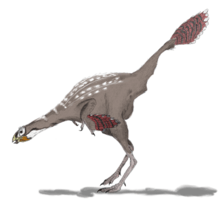 Caudipteryx Changchengornis  Concavenator .jpg) Falcarius 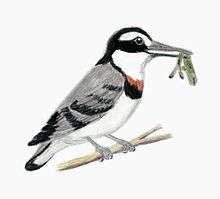 Longipteryx  Harpymimus .png) Incisivosaurus 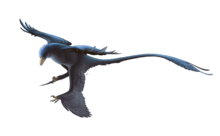 Microraptor 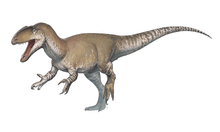 Neovenator  Shenzhousaurus 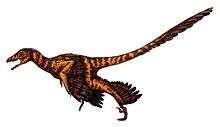 Sinornithosaurus  Utahraptor | ||
| England, Spain, Portugal | A large tetanuran theropod. Now recognised as a member of the family Spinosauridae, Baryonyx's affinities were obscure when it was discovered. | |||
| Isle of Wight, England | A small coelurosaur, possibly a compsognathid. | |||
| Isle of Wight, England | ||||
| Liaoning, China | ||||
| Liaoning, China | ||||
| Spain | A sail-backed carcharodontosaurid. | |||
| Cuenca, Spain | ||||
| Calizas de La Huérgina Formation Spain | ||||
| Utah, USA | A therizinosaur that is one of the few North American varieties of its clade. | |||
| Japan | ||||
| Gobi Desert, Mongolia | ||||
| Liaoning, China | ||||
| Cuenca, Spain | ||||
| Liaoning, China | ||||
| Liaoning, China | ||||
| Liaoning, China | ||||
|
"Nanshiungosaurus" bohlini |
||||
| Isle of Wight, England | ||||
| Cuenca, Spain | ||||
| China, Mongolia | ||||
| Liaoning, China | ||||
| Liaoning, China | ||||
|
Sao Khua Formation, Thailand |
||||
| Liaoning, China | ||||
| Liaoning, China | ||||
| Isle of Wight, England | A possible senior synonym of Valdoraptor. | |||
| Utah, USA | ||||
| Spain | ||||
| Isle of Wight, England | ||||
| Liaoning, China | ||||
†Thyreophora
| Thyreophora of the Barremian | ||||
|---|---|---|---|---|
| Taxa | Presence | Location | Description | Images |
| England |
| |||
| Utah, USA | ||||
| Liaoning, China | ||||
| England | ||||
| Gansu, China | ||||
Mammals
| Mammals of the Barremian | ||||
|---|---|---|---|---|
| Taxa | Presence | Location | Description | Images |
| EL Castellar Formation and La Huéguina Formation, Spain |  Skeleton of the primitive mammal Eomaia | |||
| several species from Hauterivian to Albian | Spain, Mongolia | |||
†Plesiosaurians
| Plesiosaurs of the Barremian | ||||
|---|---|---|---|---|
| Taxa | Presence | Location | Description | Images |
| S. munozi | Paja Formation, Altiplano Cundiboyacense, Colombia | A brachaucheniin pliosaurid, described by María Páramo | ||
†Pterosaurs
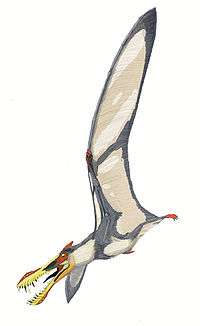
- Azhdarchoidea incertae sedis: Chaoyangopterus,[5] Jidapterus
- Ctenochasmatidae: Beipiaopterus, Liaoxipterus
- Istiodactylidae: Hongshanopterus,Istiodactylus,Longchengpterus, Nurhachius
- Ornithocheiridae: Amblydectes, Haopterus, Liaoningopterus
- Ornithocheiroidea incertae sedis: Boreopterus
- Pterodactyloidea incertae sedis: Feilongus
- Tapejaridae: Huaxiapterus, Sinopterus
References
Notes
- Super User. "ICS - Chart/Time Scale". www.stratigraphy.org.
- See Gradstein et al. (2004) or the online geowhen database (link below)
- Earliest occurrence: Upper Barremian
- Earliest occurrence: Lower Barremian
- Only known from this stage
Literature
- Cossmann, M. & Pelat, E. (1907): Le Barrémien supérieur à faciès Urgonien de Brouzet-lès-Alais (Gard). Mémoires de la Société Géologique de France, Paléontologie 15(37): 5-42. (in French)
- Gradstein, F.M.; Ogg, J.G. & Smith, A.G.; (2004): A Geologic Time Scale 2004, Cambridge University Press.
- Guzhikov, A.Yu. & Baraboshkin, E.J. (2006): Assessment of diachronism of biostratigraphic boundaries by magnetochronological calibration of zonal scales for the Lower Cretaceous of the Tethyan and Boreal belts. Doklady Earth Sciences 409(6): 843-846. doi:10.1134/S1028334X06060018
External links
- GeoWhen Database - Barremian
- Mid-Cretaceous timescale, at the website of the subcommission for stratigraphic information of the ICS
- Stratigraphic chart of the Lower Cretaceous, at the website of Norges Network of offshore records of geology and stratigraphy

